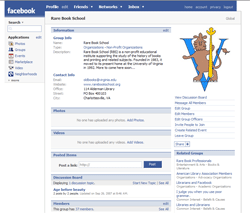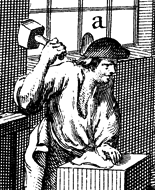RBS News Feed: 2007
Rare Book School now has a Facebook group
[ 31 October 2007 ] Rare Book School has recently formed a group on Facebook, the online social networking site that allows members to share news and announcements, photographs, contact information and more. With a growing demographic that includes working professionals and students, Facebook has become a useful tool for staying in touch with both friends and colleagues. For more information about Facebook, visit the Facebook home page or see the Rare Book School group page.
As an RBS group member, you will receive the latest updates from RBS in your newsfeed. Members can upload and tag photos, share links and videos, post shout-outs on our wall, participate on our discussion board, and even poke Terry Belanger. This is an open group, which means any Facebook member can join and invite others to join. Nominations for group officers are welcome!
The RBS website (where you are now) will remain the primary site for information about the school and its activities, but Facebook groups tend to develop a life of their own. We hope students will find the group useful in connecting with each other outside of class. Now if you lose your Vade Mecum, you'll have a place to ask where the nearest laundromat is!
Anybody seen my hammer?
[ 19 March 2007 ] In 1997, RBS acquired a stack of printed but unbound folio sheets intended to make several volumes of early c19 British House of Commons committee reports. The sheets were roughly folded for storage shortly after printing in bunches of several gatherings each, and then warehoused. If the books had been bound shortly after the dampened sheets were printed, the binder would as usual have had to flatten out the bunches and refold the individual sheets more accurately, in order to even up the gutters and get the text pages squarely one on top of the next (the imposition is folio in 2s). He would then have had to beat the folded sheets with a binder's hammer, several gatherings at a time, in order to consolidate them and make them lie flat and snug, one next to another.
The beating process is illustrated in one of the copper-plate engravings accompanying the bookbinding entry in Diderot's Encyclopédie (Paris 1751-65), a relevant detail from which is reproduced here. We're looking for an actual example of a hand-press-period binder's hammer used for this purpose, the earlier the better: does anyone know anyone who has one? If so, please email < > with information about it.
There is an excellent picture of a binder's hammer on the Mainz Gutenberg Museum website. The head of the hammer, presumably made of (cast?) iron, is probably similar to what the Encyclopédie artist drew, but his copper-plate engraver (who might not himself have been familiar with the object depicted) misread some of the detail.
Zaehnsdorf's “Art of Bookbinding” (1897) also shows a picture of a beating hammer.
Here is a description of the beating process, from George Cowie's Bookbinder's manual (London, c. 1828; facsimile edition [ed. Sidney F. Huttner, NY: Garland Publishing, Inc., 1990] as the second of Two early c19 bookbinding manuals):
Such books as are intended for the process of beating, require a large stone, with a smooth surface, and a hammer (somewhat in the shape of a bell) weighing from twelve to fourteen pounds; having these in readiness, the books are beat in the following manner: — About a dozen sheets (or sections) are held at a time, between, and near, the ends of the fingers and thumb of the left hand, while with the right hand the hammer is raised about a foot, and must fall with rather more than its own weight on the edges of the sections, which should be continually moved round, turned over, and changed, in order that they may be equally beat. During this process, the sections should be occasionally examined, to ascertain whether they have set off; if such be the case, they should have no more beating. If the work have cuts, a leaf of tissue paper should be placed between these and the letter-press. [pp. 8-9]
Contemporary bookbinding manuals like this one are an important source of information about the techniques of hand-press-period forwarding — that is, the process of folding, beating, and sewing the sheets, and attaching the boards or other covering material, before finishing — that is, decorating — takes place.
In 1747, R. Campbell published The London Tradesman, a guide to parents looking for advice on the choice of a trade into which to apprentice their children. He had little to say in favor of bookbinding:
The Bookbinder is a Dependant on the Bookseller. He receives the Book in Sheets from the Bookseller, and his Business is to bind it, and cover it with Leather, Vellum, or otherwise, as he is directed. The Trade of a Bookbinder has no great Ingenuity in it, and requires few Talents, either natural or acquired, to fit a Man to carry it on; a moderate Share of Strength is requisite, which is chiefly employed in beating the Books with a heavy Hammer, to make the Sheets lie close together. The Profit of the Trade is but inconsiderable in itself, and most Masters in this Branch carry on the Business of Stationary or Pamphlet Shops. The Journeymen make but a mean Living; they seldom earn more than Ten Shillings a Week when employed, and are out of Business for Half the Year. [p. 135]
Quiz question: Why were c18 London binders out of business for half the year?

